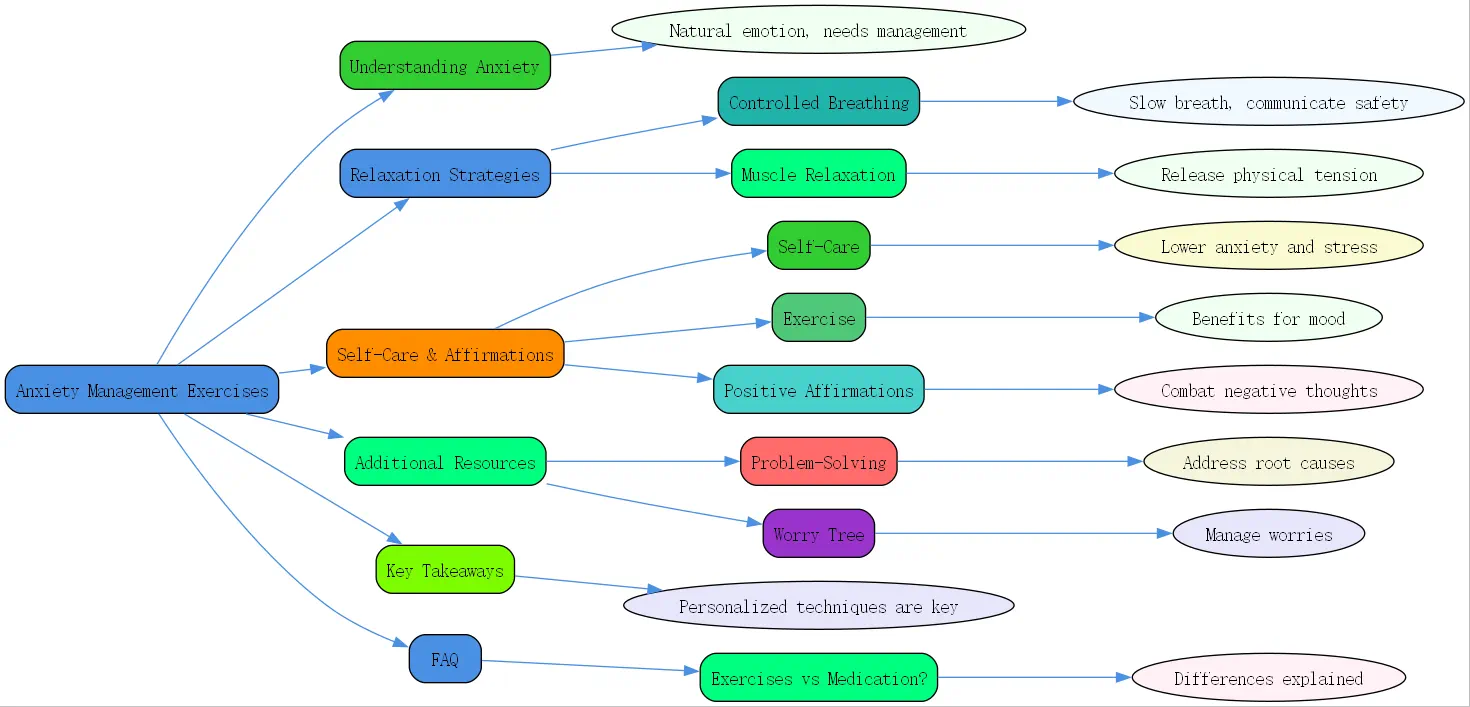Understanding Anxiety and the Need for Management

Anxiety is a natural human emotion that everyone experiences at various points in life. It serves as our body’s response to perceived threats and can be a normal, adaptive reaction to stressful situations. However, when anxiety becomes overwhelming or persistent, it can significantly impact our quality of life and daily functioning.
For individuals with learning disabilities and autism, anxiety tends to be more prevalent due to various factors including sensory sensitivities, difficulty with change, and challenges in social communication. These individuals often require additional support to manage their anxiety effectively, as heightened anxiety can lead to behaviors that may be challenging for both themselves and their caregivers.
Understanding that anxiety management is not a one-size-fits-all approach is crucial. Each person responds differently to various techniques, making it essential to identify personalized strategies that work effectively for each individual. What helps one person relax might not work for another, highlighting the importance of exploring various anxiety management exercises to build a personalized toolkit.
BrainTalking experts emphasize that the first step in anxiety management is to recognize your current coping mechanisms. Take a moment to reflect on the activities you already engage in when feeling anxious. These might include formal practices like mindfulness meditation or more casual activities like reading a book, taking a walk, exercising, practicing yoga, baking, enjoying a long bath, receiving a massage, or playing a favorite game.
Relaxation Strategies for Anxiety Stress Management Techniques
The Role of Relaxation: Reducing Anxiety and Tension Over Time
Relaxation strategies form the foundation of effective anxiety stress management techniques. While they aren’t a cure-all for anxiety disorders, consistently practicing relaxation exercises can significantly reduce general anxiety levels and physical tension over time. It’s important to note that these techniques work best as regular practices rather than one-time solutions for severe anxiety or panic attacks.
Relaxation techniques primarily work by addressing the physical manifestations of anxiety閳ユ敂educing muscle tension, slowing breathing rates, and calming the mind. By targeting these physical symptoms, relaxation exercises help interrupt the anxiety cycle and restore the body to a calmer state. These strategies can be either structured (like controlled breathing or progressive muscle relaxation) or unstructured (such as self-care activities or massage).
Controlled Breathing Exercises: Slowing Down Breath to Communicate Safety
Our breath serves as a powerful anchor that we carry with us everywhere. When feeling anxious, focusing attention on breathing can help calm both the mind and body. This is why the common advice to “”take a few deep breaths”” during moments of worry or anxiety is actually scientifically sound.
By intentionally altering the pace and depth of our breathing, we can directly influence our body’s anxiety response. Controlled breathing communicates safety to the brain and helps activate the parasympathetic nervous system閳ユ攼ur body’s “”rest and digest”” mode閳ユ攦ounteracting the “”fight or flight”” response triggered by anxiety.
Step-by-step Guide to Controlled Breathing (4-4-6 Method)
The 4-4-6 breathing method is a simple yet effective anxiety management exercise that can be practiced anywhere:
1. Find a comfortable position, preferably sitting with your back supported and feet flat on the floor 2. Place your hands on your stomach to feel it rise and fall with each breath 3. Breathe in through your nose for a count of 4 (imagine smelling a flower) 4. Hold your breath for a count of 4 5. Exhale slowly through slightly pursed lips for a count of 6 (imagine blowing out a candle) 6. Repeat this cycle several times, maintaining the 4-4-6 rhythm
Regular practice of this technique makes it more accessible when you need it during moments of heightened anxiety.
Visual Resources for Regulating Breathing
Visual aids can enhance breathing exercises, especially for individuals who may need additional support. Examples include:
- Animated breathing bubbles that expand and contract
- Breathing boards with lines that rise and fall
- Visual timers that indicate how long to inhale, hold, and exhale
- Images of flowers to “”smell”” during inhalation and candles to “”blow out”” during exhalation
These visual resources are particularly helpful when supporting individuals with learning disabilities or autism who may benefit from concrete visual guidance.
Progressive Muscle Relaxation (PMR): Tensing and Relaxing Muscle Groups for Anxiety Reduction
Progressive Muscle Relaxation (PMR) offers another powerful approach to anxiety management. This technique is based on a simple principle: deep muscle relaxation is incompatible with anxiety. When our muscles are truly relaxed, our body cannot simultaneously maintain the physical tension associated with anxiety.
PMR involves systematically tensing and then relaxing different muscle groups throughout the body. Through this practice, we learn to recognize the difference between tension and relaxation, developing the ability to release muscle tension when it builds up. This physical relaxation sends signals of safety to the brain, reducing the activation of the fight-or-flight response that fuels anxiety.

Examples of PMR Exercises (Shoulder Push, Fist Clench, Muscle Pose)
Here are some simple PMR exercises to incorporate into your anxiety management routine:
1. Shoulder Push: Push your shoulders back as far as comfortable, trying to make them touch behind you. Hold this tension for 5 seconds, then release and feel the relaxation spread through your shoulders.
2. Fist Clench: Make a tight fist with your left hand. Squeeze intensely for 5 seconds, then completely release. Notice the contrast between tension and relaxation. Repeat with your right hand.

3. Muscle Pose: Bend your arm at the elbow and tense your bicep muscle as though showing off your strength. Hold for 5 seconds, then release completely. Alternate between arms.
Adapting PMR for Individuals with Support Needs
For individuals with learning disabilities or autism, PMR can be easily adapted to be more accessible and engaging:
- Create visual cards showing each muscle-tensing action
- Incorporate PMR into playful games or routines
- Use favorite characters or themes to demonstrate the movements
- Provide physical guidance when needed
- Keep sessions brief and gradually increase duration as tolerance builds
Self-Care and Positive Affirmations for Anxiety Medication Management
The Importance of Self-Care: Lowering Anxiety and Stress
While medication may be part of anxiety treatment for some individuals, comprehensive anxiety medication management should include robust self-care practices. Self-care involves intentionally engaging in activities that promote physical and emotional well-being, serving as a foundation for anxiety reduction regardless of whether medication is part of your treatment plan.
Self-care might include connecting with loved ones, participating in social activities, engaging in personal hygiene rituals like taking a bath, pursuing hobbies, or any other activities that reduce anxiety and stress. Effective self-care isn’t a luxury閳ユ攰t’s an essential component of mental health maintenance that can enhance the effectiveness of other treatments.
Exercise as a Self-Soothing Strategy: The Benefits of Regular Exercise on Anxiety and Mood
Exercise stands out as one of the most research-supported anxiety management exercises available. Regular physical activity has been shown to:

- Reduce symptoms of anxiety
- Improve mood through the release of endorphins
- Decrease muscle tension
- Improve sleep quality
- Boost self-confidence
- Provide distraction from worrisome thoughts
BrainTalking experts emphasize that exercise doesn’t have to involve structured sports or gym routines. Activities like dancing, Zumba classes, yoga practice, or simply walking in nature can provide significant anxiety relief. The key is finding movement that feels enjoyable rather than obligatory.
Sensory Self-Soothing: Identifying Soothing Sensory Activities
Sensory experiences can powerfully impact our anxiety levels. Identifying personally soothing sensory activities can provide immediate relief during times of heightened anxiety. Common sensory self-soothing strategies include:
- Warm baths with calming scents
- Wrapping up in soft, weighted blankets
- Receiving hugs or deep pressure
- Getting a massage
- Using fidget toys or tactile tools
- Listening to calming music
- Enjoying comforting flavors or beverages
For individuals with autism, understanding specific sensory preferences and sensitivities is particularly important. Offering sensory activities tailored to their unique needs can effectively lower arousal levels and reduce anxiety. This might include access to preferred textures, sounds, or movements that they find regulating.
Positive Affirmations and Coping Statements: Combating Negative Self-Talk
Anxiety often brings with it a barrage of negative self-talk. When anxious, we may catch ourselves thinking or saying phrases like “”I’m useless,”” “”I can’t do this,”” or “”Everything always goes wrong.”” These negative thoughts actually reinforce anxiety by suggesting that the situation is dangerous or unmanageable, creating a self-perpetuating cycle of anxiety.
Positive affirmations offer a powerful counter to this negative self-talk. By intentionally replacing negative thoughts with encouraging statements, we can influence our emotional state and reduce anxiety over time. Research shows that positive coping statements can:
- Reduce sensitivity to perceived threats
- Predict less anxious responses to challenging situations
- Make difficult circumstances seem more manageable
- Boost self-esteem
- Redirect focus away from negative thought patterns
Examples of Positive Affirmations (I can do this, This will pass)
Effective coping statements you might use include:
- “”Stop and breathe. I can do this.””
- “”This feeling will pass. It’s temporary.””
- “”I can be anxious and still handle this situation.””
- “”I’ve gotten through difficult times before and can do it again.””
- “”Right now, I am safe.””
- “”It’s okay to feel this way. This is a normal reaction.””
- “”I have the skills to manage this anxiety.””
When supporting others with anxiety, sharing positive statements or gestures can provide crucial encouragement. Simple phrases like “”You are safe”” or “”You’re doing so well”” can offer reassurance during anxious moments. For maximum effectiveness, positive statements should be phrased in the present tense, be realistic, and focus on strengths and capabilities.
Additional Anxiety Management Resources: Anxiety Management Course
For those seeking more comprehensive support, structured anxiety management courses offer in-depth training in various techniques. These courses typically build upon foundational practices like breathing and relaxation while introducing more advanced strategies.
Exploring Problem-Solving Techniques
Problem-solving is a critical component of anxiety management that focuses on addressing the actual situations triggering anxiety rather than just managing the symptoms. A structured problem-solving approach typically involves: 1. Clearly defining the problem causing anxiety 2. Brainstorming potential solutions 3. Evaluating the pros and cons of each solution 4. Selecting and implementing the most promising approach 5. Reviewing the outcome and adjusting as needed
This methodical approach can help reduce anxiety by increasing confidence in your ability to handle challenging situations effectively.
Utilizing the Worry Tree Method
The Worry Tree is a practical decision-making tool for managing worrisome thoughts. This method helps distinguish between worries you can take action on versus those beyond your control. The process follows a flowchart structure: 1. Notice the worry 2. Ask: “”Is this something I can do something about?”” 3. If no: Practice letting go and refocus attention 4. If yes: Decide on action and when to take it, then refocus attention
This simple but powerful technique prevents unproductive rumination while encouraging practical problem-solving for actionable concerns.
Further Learning: Anxiety Management Video Level 2
For those interested in expanding their anxiety management toolkit beyond the basics covered here, BrainTalking recommends exploring advanced resources like their Anxiety Management Level 2 content. These advanced materials build upon foundational techniques and introduce more sophisticated strategies for managing complex anxiety situations.
Key Takeaways for Effective Anxiety Management
- Anxiety is a natural emotion that can be effectively managed with the right techniques
- Controlled breathing exercises provide immediate physiological calming
- Progressive Muscle Relaxation helps identify and release physical tension
- Regular exercise significantly reduces anxiety symptoms
- Self-care and sensory soothing create a foundation for emotional regulation
- Positive affirmations combat anxiety-producing negative thoughts
- Problem-solving skills address the root causes of situational anxiety
- Personalization is key閳ユ攩ind and practice the techniques that work best for you
Frequently Asked Questions
How do anxiety management exercises differ from anxiety medication management?
Anxiety management exercises and medication represent complementary approaches to anxiety treatment. Exercises like controlled breathing, PMR, and positive affirmations address the physical, behavioral, and cognitive aspects of anxiety through skills development and practice. They provide tools individuals can use independently to manage symptoms.
Anxiety medication management, on the other hand, involves pharmaceutical interventions prescribed by healthcare providers to address the neurochemical aspects of anxiety disorders. Medications like SSRIs, benzodiazepines, or beta-blockers work by altering brain chemistry or physiological responses.




